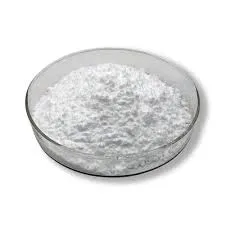
Окт . 17, 2024 07:50 Back to list
hpmc glass transition temperature
Understanding the Glass Transition Temperature in Hard Particle Systems Using HPMC
The glass transition temperature (Tg) is a critical concept in material science, especially when it comes to polymers and various composite materials. It marks the transition between a brittle, glassy state and a more flexible, rubbery state in amorphous materials. This article delves into exploring the glass transition temperature in hard particle systems, particularly focusing on Hydroxypropyl Methylcellulose (HPMC), a widely used cellulose derivative in various applications, including pharmaceuticals, food, and construction.
What is HPMC?
Hydroxypropyl Methylcellulose is a non-ionic, cellulose-based polymer that is extensively used due to its excellent binding, thickening, and film-forming properties. It is soluble in water and forms a clear viscous solution, making it ideal for various applications. In the context of pharmaceuticals, HPMC is often utilized as a former in controlled-release formulations, in food as a thickening agent, and in construction materials for improving workability.
The Importance of Glass Transition Temperature
The glass transition temperature (Tg) is essential for understanding the mechanical and thermal properties of materials. It is the temperature at which the polymer transitions from a rigid, glassy state to a softer, more pliable state. For HPMC and similar polymers, Tg affects their solubility, viscosity, and stability; thus, it plays a significant role in the performance of products that contain these materials.
For HPMC, Tg is influenced by the molecular weight, degree of substitution, and environmental factors such as humidity and temperature. This characteristic allows HPMC to be tailored for specific applications, enhancing its utility in various fields.
Factors Affecting Tg in HPMC
1. Molecular Weight The molecular weight of HPMC significantly influences its Tg. Higher molecular weight polymers exhibit higher Tg values due to the increased number of intermolecular interactions that provide greater rigidity.
2. Degree of Substitution The degree of substitution (DS) refers to the average number of hydroxyl groups that are replaced by hydroxypropyl and methyl groups. A higher degree of substitution generally leads to lower Tg values, as the presence of bulky substituents disrupts the packing of polymer chains, allowing for greater mobility.
hpmc glass transition temperature

3. Moisture Content HPMC is hygroscopic, meaning it can absorb moisture from the environment. The presence of water can plasticize the polymer, effectively lowering its Tg. This is particularly important in applications where environmental humidity can vary, affecting the material's properties.
4. Additives and Blends The inclusion of plasticizers, fillers, or other polymers can also affect the Tg of HPMC-based systems. Plasticizers, for instance, lower the Tg by increasing the free volume within the polymer matrix, thereby enhancing chain mobility and flexibility.
Characterization of Tg
Determining the Tg of HPMC can be performed using several techniques, including Differential Scanning Calorimetry (DSC), Dynamic Mechanical Analysis (DMA), and Thermomechanical Analysis (TMA). Among these, DSC is the most commonly used method as it provides a clear indication of thermal transitions, enabling researchers to evaluate the Tg precisely.
Implications for Applications
Understanding and accurately determining the glass transition temperature of HPMC is crucial for optimizing its usage in various industries. For instance, in pharmaceutical applications, knowing the Tg can help in predicting the release profile of drugs from HPMC-based formulations. In food products, it ensures the desired texture and stability during storage.
Additionally, in construction, HPMC's performance as a binder and additive is tied to its Tg, influencing the workability and durability of mortars and plasters.
Conclusion
The glass transition temperature is a vital property of Hydroxypropyl Methylcellulose, impacting its performance across multiple applications. By understanding the factors affecting Tg, manufacturers and researchers can better tailor HPMC for their specific needs, leading to improved product quality and performance. Ongoing research in the field will undoubtedly continue to explore the intricacies of HPMC and its applications, contributing to advancements in material science and engineering.
-
Unlocking the Benefits of HPMC Products: A Gateway to Versatile Applications
NewsAug.07,2025
-
Unleashing the Potential of HPMC Ashland: A Comprehensive Look
NewsAug.07,2025
-
Tile Bonding Cellulose: The Key to Superior Adhesion and Durability
NewsAug.07,2025
-
Hydroxypropyl Methylcellulose Powder: The Versatile Component in Modern Pharmaceuticals
NewsAug.07,2025
-
Hydroxyethyl Cellulose: The Versatile Solution for Various Industries
NewsAug.07,2025
-
Hydroxyethyl Cellulose (HEC): The Versatile Polymer for Various Applications
NewsAug.07,2025







